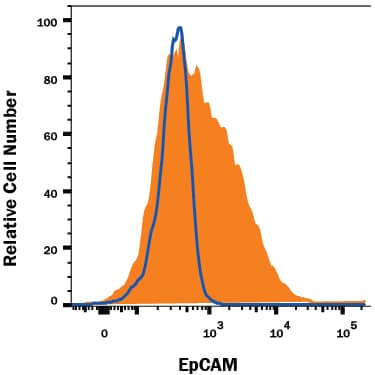Mouse
EpCAM/TROP-1 Antibody
R&D Systems, part of Bio-Techne | Catalog # MAB8998
Recombinant Monoclonal Antibody.


Conjugate
Catalog #
Key Product Details
Species Reactivity
Mouse
Applications
CyTOF-reported, Flow Cytometry
Label
Unconjugated
Antibody Source
Recombinant Monoclonal Rat IgG2A Clone # G8.8R
Product Specifications
Immunogen
TE-71 Thymic epithelial cell line
Specificity
Detects mouse EpCAM/TROP-1.
Clonality
Monoclonal
Host
Rat
Isotype
IgG2A
Scientific Data Images for Mouse EpCAM/TROP-1 Antibody
Detection of EpCAM/TROP‑1 in 4T1 Mouse Cell Line by Flow Cytometry.
4T1 mouse breast cancer cell line was stained with Rat Anti-Mouse EpCAM/TROP-1 Monoclonal Antibody (Catalog # MAB8998, filled histogram) or isotype control antibody (Catalog # MAB006, open histogram), followed by Phycoerythrin-conjugated Anti-Rat IgG Secondary Antibody (F0105B).Detection of EpCAM/TROP‑1 in mIMCD3 Mouse Cell Line by Flow Cytometry.
mIMCD3 mouse kidney cell line was stained with Rat Anti-Mouse EpCAM/TROP-1 Monoclonal Antibody (Catalog # MAB8998, filled histogram) or isotype control antibody (MAB006, open histogram), followed by Phycoerythrin-conjugated Anti-Rat IgG Secondary Antibody (F0105B).Applications for Mouse EpCAM/TROP-1 Antibody
Application
Recommended Usage
CyTOF-reported
Lujan, E. et al. (2015) Nature 521: 352.
Flow Cytometry
0.25 µg/106 cells
Sample: mIMCD3 mouse kidney cell line and 4T1 mouse breast cancer cell line
Sample: mIMCD3 mouse kidney cell line and 4T1 mouse breast cancer cell line
Formulation, Preparation, and Storage
Purification
Protein A or G purified from cell culture supernatant
Reconstitution
Reconstitute at 0.5 mg/mL in sterile PBS. For liquid material, refer to CoA for concentration.
Formulation
Lyophilized from a 0.2 μm filtered solution in PBS with Trehalose. *Small pack size (SP) is supplied either lyophilized or as a 0.2 µm filtered solution in PBS.
Shipping
Lyophilized product is shipped at ambient temperature. Liquid small pack size (-SP) is shipped with polar packs. Upon receipt, store immediately at the temperature recommended below.
Stability & Storage
Use a manual defrost freezer and avoid repeated freeze-thaw cycles.
- 12 months from date of receipt, -20 to -70 °C as supplied.
- 1 month, 2 to 8 °C under sterile conditions after reconstitution.
- 6 months, -20 to -70 °C under sterile conditions after reconstitution.
Background: EpCAM/TROP1
References
- Litvinow, S.V. et al. (1994) J. Cell Biol. 125:437.
- Balzar, M. et al. (2001) Mol. Cell. Biol. 21:2570.
- Balzar, M. et al. (1998) Mol. Cell. Biol. 18:4388.
Long Name
Epithelial Cell Adhesion Molecule
Alternate Names
17-1A, CD326, GA733-2, gp40, KS1/4, M4S1, TACSTD1, TROP1
Gene Symbol
EPCAM
Additional EpCAM/TROP1 Products
Product Documents for Mouse EpCAM/TROP-1 Antibody
Product Specific Notices for Mouse EpCAM/TROP-1 Antibody
For research use only
